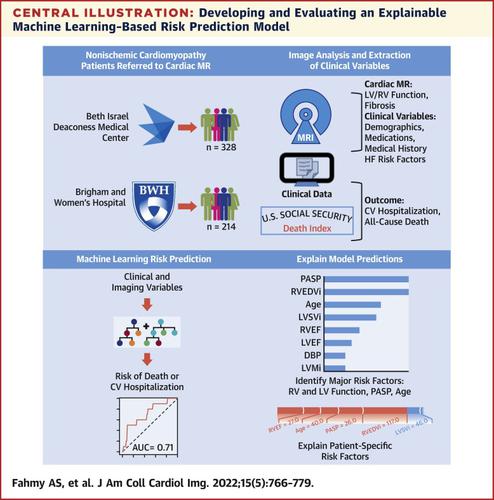JACC: Cardiovascular Imaging ( IF 12.8 ) Pub Date : 2022-01-12 , DOI: 10.1016/j.jcmg.2021.11.029 Ahmed S Fahmy 1 , Ibolya Csecs 2 , Arghavan Arafati 1 , Salah Assana 1 , Tuyen T Yankama 1 , Talal Al-Otaibi 1 , Jennifer Rodriguez 1 , Yi-Yun Chen 3 , Long H Ngo 1 , Warren J Manning 2 , Raymond Y Kwong 3 , Reza Nezafat 1

|
Objectives
The authors implemented an explainable machine learning (ML) model to gain insight into the association between cardiac magnetic resonance markers and adverse outcomes of cardiovascular hospitalization and all-cause death (composite endpoint) in patients with nonischemic dilated cardiomyopathy (NICM).
Background
Risk stratification of patients with NICM remains challenging. An explainable ML model has the potential to provide insight into the contributions of different risk markers in the prediction model.
Methods
An explainable ML model based on extreme gradient boosting (XGBoost) machines was developed using cardiac magnetic resonance and clinical parameters. The study cohorts consist of patients with NICM from 2 academic medical centers: Beth Israel Deaconess Medical Center (BIDMC) and Brigham and Women’s Hospital (BWH), with 328 and 214 patients, respectively. XGBoost was trained on 70% of patients from the BIDMC cohort and evaluated based on the other 30% as internal validation. The model was externally validated using the BWH cohort. To investigate the contribution of different features in our risk prediction model, we used Shapley additive explanations (SHAP) analysis.
Results
During a mean follow-up duration of 40 months, 34 patients from BIDMC and 33 patients from BWH experienced the composite endpoint. The area under the curve for predicting the composite endpoint was 0.71 for the internal BIDMC validation and 0.69 for the BWH cohort. SHAP analysis identified parameters associated with right ventricular (RV) dysfunction and remodeling as primary markers of adverse outcomes. High risk thresholds were identified by SHAP analysis and thus provided thresholds for top predictive continuous clinical variables.
Conclusions
An explainable ML-based risk prediction model has the potential to identify patients with NICM at risk for cardiovascular hospitalization and all-cause death. RV ejection fraction, end-systolic and end-diastolic volumes (as indicators of RV dysfunction and remodeling) were determined to be major risk markers.
中文翻译:

一种可解释的机器学习方法揭示了非缺血性心肌病右心室功能障碍的预后意义
目标
作者实施了一个可解释的机器学习 (ML) 模型,以深入了解非缺血性扩张型心肌病 (NICM) 患者的心脏磁共振标志物与心血管住院和全因死亡(复合终点)的不良后果之间的关联。
背景
NICM 患者的风险分层仍然具有挑战性。可解释的 ML 模型有可能深入了解预测模型中不同风险标记的贡献。
方法
使用心脏磁共振和临床参数开发了基于极端梯度增强 (XGBoost) 机器的可解释 ML 模型。研究队列由来自 2 个学术医疗中心的 NICM 患者组成:贝丝以色列女执事医疗中心 (BIDMC) 和布莱根妇女医院 (BWH),分别有 328 名和 214 名患者。XGBoost 对 BIDMC 队列中 70% 的患者进行了培训,并根据其他 30% 的患者进行了评估作为内部验证。该模型使用 BWH 队列进行了外部验证。为了研究不同特征在我们的风险预测模型中的贡献,我们使用了 Shapley 加性解释 (SHAP) 分析。
结果
在 40 个月的平均随访期间,来自 BIDMC 的 34 名患者和来自 BWH 的 33 名患者经历了复合终点。对于内部 BIDMC 验证,预测复合终点的曲线下面积为 0.71,对于 BWH 队列为 0.69。SHAP 分析将与右心室 (RV) 功能障碍和重塑相关的参数确定为不良结果的主要标志物。通过 SHAP 分析确定了高风险阈值,从而为顶级预测性连续临床变量提供了阈值。
结论
一个可解释的基于 ML 的风险预测模型有可能识别出有心血管住院和全因死亡风险的 NICM 患者。RV 射血分数、收缩末期和舒张末期容积(作为 RV 功能障碍和重塑的指标)被确定为主要风险标志物。











































 京公网安备 11010802027423号
京公网安备 11010802027423号